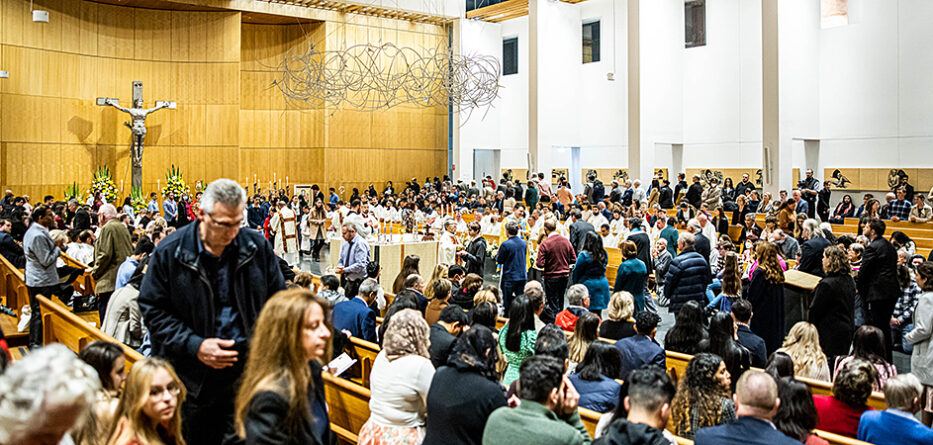INTRUSIONS
Where the difference between devotions and liturgy has not yet been well understood, efforts are still being made to re-insert various devotions into the liturgy, and objects of devotion into the sanctuary. But nothing is more striking than the “noble simplicity” of which the Introduction to the Roman Missal speaks.
There have been sporadic efforts to re-introduce the maniple, the biretta, etc, but these are more usual with fringe groups, which tells its own story. Good ritual doesn’t need things that have lost their meaning. For example: when the priest had his back to the congregation and prayed the Eucharistic Prayer quietly, in Latin, the people had no way of knowing where he was up to. And so, a bell was rung at various stages of the Mass to help the people know. The current rubric allows that a small bell may be rung “if appropriate,” “as a signal to the faithful” (it has no other meaning) – e.g. in a large congregation where it may be difficult for people to see or hear. But in a small building, where the people are carefully following the prayer which they can hear clearly, the sudden interruption of a bell can be quite a distraction.
Some ways of not causing distraction during the Eucharistic Prayer seem to be little more than common courtesies. But many of them come back to the fact that one voice prayerfully proclaiming the Eucharistic Prayer helps the prayerful participation of the people, and so the less shuffling around at the altar the better. This led priests and bishops, some years ago, to forgo options that are open to them, such as sharing different parts of the Eucharistic Prayer among the concelebrants, all concelebrants saying the words of institution out loud, bishops putting mitres off and on during the Mass…Forgoing such options occurs naturally to those who think of the congregation’s needs more than their own prerogatives.
SAME SIGNS, DIFFERENT MEANINGS:
Of course, “secondary things” and “externals” are often intended to point beyond themselves. Signs are a kind of language. Clerical dress is an example of this, and of a recent push-back. Dress can be a sign of being different, separate, apart. Alternatively, it can indicate closeness to people, being one with them. What counts is not what our signs means to ourselves, but what they mean to those we want to communicate with. Up-to-date research by the Wilberforce Foundation (Faith and Belief, 2023) confirms that it is not status or position that attracts New Zealanders to explore the faith:
“People living in Aotearoa New Zealand value authenticity with 66% of respondents being attracted to explore spirituality if they see people living out a genuine faith or spirituality first-hand. Authenticity around faith and spirituality in conversations is … a key factor in leading individuals to consider faith or spiritual matters…” (p.28)
Then, more pointedly, it says: “the number one repellent to exploring faith and spirituality” was hearing it from people who publicly and officially represent it. The reasons for this might not be recent scandals, because the Wilberforce Study goes on to say that:
“… the above finding does not hold for the younger generation, who are more open to influencers. Gen Z are the most likely generation to investigate faith or spirituality if they hear it from a representative public figure…
“Gen Z are also the most likely to be attracted to exploring spirituality further because of stories or testimonies from people who have changed because of their faith or spirituality… ” (p 28).
So, perhaps the research is saying, as many Catholics do, that ministry is not helped by regalia, customs or titles that symbolise power – the remnants of Christendom. Adaptation to pastoral need goes with being incarnational – being not of the world, but truly in it nevertheless – not just physically, but also socially. In 1971, the International Theological Commission had warned against “the tendency to form a separate caste”.
I have been struck by the coincidence of two unrelated events: in order not to re-traumatise victims, the NZ bishops knew better than to wear clericals when they came before the Royal Commission. Nearly fifty years earlier, one of our most pastorally dedicated priests had been visiting a hospital; when he told the nurse that a patient he visited had seemed agitated, she told him that the monitoring machines often showed a rise in blood pressure and pulse rates when “you men come in dressed in deep black”. After that he was always smartly dressed and identifiable as a priest, but never again in “deep black.” We needed to be sensitive to these matters because how we come across is meant to be for the benefit of others, and not just to satisfy some inner need of our own.
Throughout the Church, pastoral savvy has resulted in many different forms of clerical dress. It’s the mission that doesn’t change. Some push-back on this account comes out of a pious exaggeration relating to ordination which led Pope St John Paul II to remind us that “what one becomes through ordination is in the realm of function, not dignity or holiness” (Christi Fideles Laici, 51). It is the function that is special.
THE IMPORTANCE OF BELONGING
Our “small family arguments” do not cancel our belonging. They take place within the context of family bonds that go deeper than differences. There is a Catholic culture formed through the inter-action the Church’s scriptures, liturgies, devotions, hymns, literature, art, pilgrimages, parishes, religious communities, schools, work for justice, peace, development and health care, personal sacrifices, faithfulness… Within this culture, the desire to belong is mysteriously stronger than anything that offends.
But I could be accused of avoiding the more serious issues if I omitted to acknowledge the kind of differences that can threaten unity within the Church. At one level, the continued use of the unrevised Missal might seem harmless enough – live and let live. But it can also smudge reality: a General Council of the Church mandated a revision of the Missal, and every Pope since has emphasised that continued use of the unrevised Missal is a special concession for specific pastoral needs. In other words, the revised and unrevised Missals are not just alternative, ordinary, ways of celebrating Mass. What matters here is not just the difference between two Missals; it is our Catholic practice of accepting the mandate of a General Council, and its endorsement by all subsequent Popes.
There is no point in blaming Pope Francis: he is the one charged by the Holy Spirit to preside over the unity of the Church. Fortunately, he can be unphased by small family arguments, but he is also clear about the boundaries of unity. Our prayers for him need to be accompanied by our loyalty.
Bishop Peter Cullinane is Bishop Emeritus of The Diocese of Palmerston North, New Zealand. This is the second part of a two-part article.
READ: Small family arguments – Part 1: Polarisation and Pushback
This article was originally published in the 7 – 20 April edition of NZ Catholic, a news publication of the Diocese of Auckland. Reproduced with permission.








